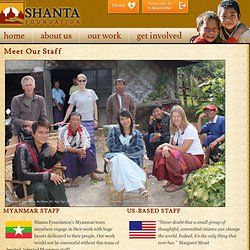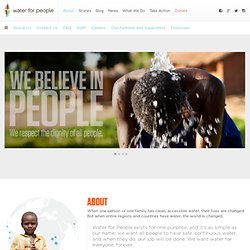

Burma context. Who are Burma's minority groups? More than 40% of people living in Burma belong to one of the military-ruled nation's different minority groups.

The government recognises eight distinct ethnic groups, with dozens of sub-groups, but refuses to acknowledge others. As the country holds its first elections in 20 years, the BBC profiles some of the main minority groups. Click on each image to find out more. Karenni The Karenni are a branch of the Karen ethnic group - their name means the Red Karens. Kachin The Kachin, originally thought to have come from Tibet, encompass several smaller ethnic sub-groups. Chin The Chin were originally animist but mostly converted to Christianity in the 19th Century.
Wa The Wa live primarily in the self-administrative division of Shan state. Rohingya The mostly Muslim Rohingya are considered one of the world's most persecuted minority groups. Shan. General development. MIDO – About Us. About Us Categories: , | written on April 12th, 2012 ICT for Development For Developing countries, ICT can be used as a tool for economic growth and social advancement in short period of time.

Having poor ICT infrastructures in Myanmar, there is a massive and significant digital divide amongst the urban and the rural areas. Due to several limitations, Myanmar has the Internet Penetration rate of only 3% the most. What is MIDO? MIDO (Myanmar ICT for Development Organization ) is a Myanmar based, non governmental and Non-Profit Organization. How MIDO contributes ICT for Development MIDO provides the following ICT for development services and toolkits; Provide Seminars on ICT awareness mainly to rural and suburban areasOrganize Workshop on Capacity building on ICTConduct Basic ICT/Computer trainingsResearch and develop Myanmar’s ICT for development reports and papers Vision Mission Organization Structure Our Team 1.
Nay Phone Latt – Executive Director Htaike Htaike Aung – Program Manager. Partners Relief & Development. Apr22 2014 I find it easiest to compare the Burma story with something we are more familiar with in the West.

It helps people to understand the feelings people in the center of the Burma story have. My grandfathers both fought in WWII to liberate Europe and Africa from the Nazi terror. Many of us are familiar with that story. Imagine Imagine that you are from France (which borders Germany) and that the Nazi’s have invaded your city. For many ethnics from Burma, this is how they feel. Colorado Burma Roundtable Network.
Birambye Lodge - Mugonero, Rwanda. "Birambye" is Kinyarwandan for "Sustainability" Listen to a recent radio documentary here A new model: Birambye Lodge is a true social business in that all the profits will be funneled into the L’Esperance Orphanage for the care and education of the children.

With the traditional orphanage funding model, funds, social welfare, and ecology deplete after the initial investment. To sustain, the orphanage must rely on unpredictable charitable giving. Birambye Lodge will sit on the shore of beautiful Lake Kivu in western Rwanda. Sustainable technology: The Birambye Lodge is pursuing sustainable technologies that help solve energy and water problems in the region. Sustainable income: Like many non-profits, L’Esperance Orphanage relies heavily on the charitable giving of others to serve the children. Sustainable support: The Birambye Lodge will help support L’Esperance. About L’Esperance: Volunteerism. Orbis Institute. Shanta Foundation. Seated: Kyaw Moe, Ko Shwe, Dr.

Nge Nge, Khun Gyi, Tricia, Thar Nge | Standing: Mike, Katherine Hollis, Ko Pyue Shanta Foundation’s Myanmar team members engage in their work with huge hearts dedicated to their people. Our work would not be successful without this team of devoted, talented Myanmar staff! Dr. Nge Nge Khaingzar Oo Regional Manager Dr. Thar Nge Zaw Tint Hlaing Economic Development Manager Thar Nge is responsible for Shanta’s construction and infrastructure projects, economic development programs, and the organization’s finances.
Thar Nge was Shanta’s first staff member who began as a volunteer in 2006 managing the construction of our first primary school in Yim Bya village. Ko Shwe Education Manager Ko Shwe joined Shanta’s staff in April 2011 after spending three years with Save the Children. Medical Teams International Your gift today helps save lives. iDE - D90 Network. How a coalition of Coloradans created the nation's first collaborative center for international development In 2011, iDE brought a pioneering exhibition to Colorado.

"Design for the Other 90%" featured 30 innovative, practical and extremely affordable devices; from ceramic water filters to solar-powered hearing aids— that could change billions of lives around the globe. The exhibition drew its title and its inspiration from iDE founder Paul Polak. "The majority of the world's designers focus all their efforts on developing products and services exclusively for the richest 10 percent of the world's consumers," Dr. Polak pointed out. Now iDE is leading that revolution in a new direction, by creating the nation's first collaborative center for international development. Education. Asian Pacific. Sanitation and Hygiene. iDE. Water for people: about us. Where does Water For People work?

Water For People currently works in 10 countries around the world: Honduras, Guatemala, Nicaragua, Bolivia, Peru, Ecuador, Malawi, Rwanda, Uganda, and India. Our employees in-country know the culture, language, and communities we serve. However, based on special grants and funding, we have worked in more than 40 other countries over the years but have found that a targeted approach is more effective and efficient. What makes Water for People unique from other water and sanitation organizations? Water For People works towards ‘full-coverage’ This means, every family, every school, and every clinic receives access to safe water and sanitation.
Capacity-building is critical to our work This means Water For People ensures that when something breaks, someone has the capacity to fix it. Co-finance.